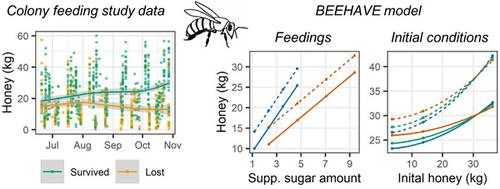当前位置:
X-MOL 学术
›
Environ. Toxicol. Chem.
›
论文详情
Our official English website, www.x-mol.net, welcomes your feedback! (Note: you will need to create a separate account there.)
Simulating Honey Bee Large-Scale Colony Feeding Studies Using the BEEHAVE Model-Part II: Analysis of Overwintering Outcomes.
Environmental Toxicology and Chemistry ( IF 4.1 ) Pub Date : 2020-08-10 , DOI: 10.1002/etc.4844 Farah Abi-Akar 1 , Amelie Schmolke 1 , Colleen Roy 1 , Nika Galic 2 , Silvia Hinarejos 3
Environmental Toxicology and Chemistry ( IF 4.1 ) Pub Date : 2020-08-10 , DOI: 10.1002/etc.4844 Farah Abi-Akar 1 , Amelie Schmolke 1 , Colleen Roy 1 , Nika Galic 2 , Silvia Hinarejos 3
Affiliation

|
Large‐scale colony feeding studies (LSCFSs) aim to assess potential pesticide exposure to and effects on honey bees at the colony level. However, these studies are sometimes affected by high losses of control colonies, indicating that other stressors may impact colonies and confound the analysis of potential pesticide impacts. We assessed the study design and environmental conditions experienced by the untreated control colonies across 7 LSCFSs conducted in North Carolina (USA). Overwintering success differed considerably among the studies, as did their initial colony conditions, amount and timing of sugar feeding, landscape composition, and weather. To assess the effects of these drivers on control colonies' overwintering success, we applied the mechanistic colony model BEEHAVE. Sugar feedings and initial status of the simulated colonies were more important for fall colony condition than were landscape and weather. Colonies that had larger colony sizes and honey stores in the fall were those that began with larger honey stores, were provided more sugar, and had supplemental feedings before the fall. This information can be used to inform the standardization of a study design, which can increase the likelihood of overwintering survival of controls and help ensure that LSCFSs are comparable. Our study demonstrates how a mechanistic model can be used to inform study designs for higher tier effects studies. Environ Toxicol Chem 2020;39:2286–2297. © 2020 The Authors. Environmental Toxicology and Chemistry published by Wiley Periodicals LLC on behalf of SETAC.
中文翻译:

使用BEEHAVE模型模拟蜜蜂大规模集落饲养研究(第二部分:越冬结果分析)。
大规模菌落摄食研究(LSCFS)旨在评估菌落水平对蜜蜂的潜在农药暴露及其影响。但是,这些研究有时会受到控制菌落大量损失的影响,这表明其他胁迫因素可能会影响菌落并混淆潜在农药影响的分析。我们评估了在北卡罗来纳州(美国)进行的7个LSCFS中未经处理的对照菌落所经历的研究设计和环境条件。在这些研究中,越冬成功率差异很大,它们的初始菌落条件,食糖量和时间,景观组成和天气也有很大差异。为了评估这些驱动因素对控制菌落越冬成功的影响,我们应用了机械菌落模型BEEHAVE。糖的摄食量和模拟菌落的初始状态对秋季菌落状况比景观和天气更为重要。在秋天具有较大菌落大小和蜂蜜储存量的菌落,是从较大的蜂蜜储存库开始的菌落,提供了更多的糖,并且在秋天之前补充了饲料。此信息可用于告知研究设计的标准化,这可以增加对照越冬存活率的可能性,并有助于确保LSCFS具有可比性。我们的研究表明如何使用机械模型为更高层效应研究提供信息。并且在秋天之前补充了饲料。此信息可用于告知研究设计的标准化,这可以增加对照越冬存活率的可能性,并有助于确保LSCFS具有可比性。我们的研究表明如何使用机械模型为更高层效应研究提供信息。并且在秋天之前补充了饲料。此信息可用于告知研究设计的标准化,这可以增加对照越冬存活率的可能性,并有助于确保LSCFS具有可比性。我们的研究表明如何使用机械模型为更高层效应研究提供信息。2020年《环境毒理学》; 39:2286-2297。©2020作者。Wiley Periodicals LLC代表SETAC发布的《环境毒理学和化学》。
更新日期:2020-08-10
中文翻译:

使用BEEHAVE模型模拟蜜蜂大规模集落饲养研究(第二部分:越冬结果分析)。
大规模菌落摄食研究(LSCFS)旨在评估菌落水平对蜜蜂的潜在农药暴露及其影响。但是,这些研究有时会受到控制菌落大量损失的影响,这表明其他胁迫因素可能会影响菌落并混淆潜在农药影响的分析。我们评估了在北卡罗来纳州(美国)进行的7个LSCFS中未经处理的对照菌落所经历的研究设计和环境条件。在这些研究中,越冬成功率差异很大,它们的初始菌落条件,食糖量和时间,景观组成和天气也有很大差异。为了评估这些驱动因素对控制菌落越冬成功的影响,我们应用了机械菌落模型BEEHAVE。糖的摄食量和模拟菌落的初始状态对秋季菌落状况比景观和天气更为重要。在秋天具有较大菌落大小和蜂蜜储存量的菌落,是从较大的蜂蜜储存库开始的菌落,提供了更多的糖,并且在秋天之前补充了饲料。此信息可用于告知研究设计的标准化,这可以增加对照越冬存活率的可能性,并有助于确保LSCFS具有可比性。我们的研究表明如何使用机械模型为更高层效应研究提供信息。并且在秋天之前补充了饲料。此信息可用于告知研究设计的标准化,这可以增加对照越冬存活率的可能性,并有助于确保LSCFS具有可比性。我们的研究表明如何使用机械模型为更高层效应研究提供信息。并且在秋天之前补充了饲料。此信息可用于告知研究设计的标准化,这可以增加对照越冬存活率的可能性,并有助于确保LSCFS具有可比性。我们的研究表明如何使用机械模型为更高层效应研究提供信息。2020年《环境毒理学》; 39:2286-2297。©2020作者。Wiley Periodicals LLC代表SETAC发布的《环境毒理学和化学》。


























 京公网安备 11010802027423号
京公网安备 11010802027423号